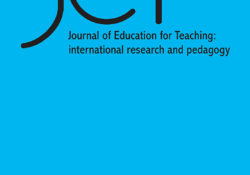tandfonline.com har udgivet en rapport under søgningen “Teacher Education Mathematics”: ABSTRACT ABSTRACT In the United States, educator preparation is regulated at the state level. Accordingly, each state education system, and even individual districts, responded uniquely to the COVID-19 pandemic. Western Governors University (WGU) compiled a list of each state regulators’ response to COVID, many of which included relaxation of student teaching requirements. While most of WGU’s teacher preparation programme is delivered online, students complete observations and student teaching (teaching practice) in traditional classrooms. WGU had 1,875 student teacher candidates in the field on 1 March 2020. Through diligent effort all the candidates were able to complete their student teaching. WGU responded by allowing parallelism between the student teachers and their mentor teacher so that the student teacher could engage in teaching in the… Continue Reading →
Like this:
Like Loading...
eric.ed.gov har udgivet: Representatives from the Michigan Department of Education and the Center for Educational Performance and Information requested assistance in estimating Michigan’s capacity to adequately staff its high schools to meet the course requirements of the new Michigan Merit Curriculum. The study team devised a formula to estimate the number of additional full-time equivalent (FTE) teachers needed for each subject at each Michigan high school. The formula was calculated using Michigan-specific values for key variables. Such an analysis may be particularly useful when new graduation or course requirements are being planned. Schools can adjust the variables in the formula (such as class size and number of periods taught by each FTE teacher) to fit their own needs. Analysis of data for Michigan high schools identified a number of schools… Continue Reading →
Like this:
Like Loading...
eric.ed.gov har udgivet: Traditionally, states have required individuals complete a program of study in a university-based teacher preparation program in order to be licensed to teach. In recent years, however, various “alternative certification” programs have been developed and the number of teachers obtaining teaching certificates through routes other than completing a traditional teacher preparation program has skyrocketed. In this paper I use a rich longitudinal data base from Florida to compare the characteristics of alternatively certified teachers with their traditionally prepared colleagues. I then analyze the relative effectiveness of teachers who enter the profession through different pathways by estimating “value-added” models of student achievement. In general, alternatively certified teachers have stronger pre-service qualifications than do traditionally prepared teachers, with the least restrictive alternative attracting the most qualified perspective teachers. These… Continue Reading →
Like this:
Like Loading...
eric.ed.gov har udgivet: Given the policy goals of course graduation requirements (CGRs), this study first tests the hypothesis that CGRs promote academic excellence and equity by both improving student performance (“productivity hypothesis”) and reducing the gap between student groups as defined by academic ability, race/ethnicity, and socioeconomic status (“equality hypothesis”). This study also assesses whether and how schools differ in CGRs’ effects by testing the following hypotheses that CGRs affect student outcomes more positively in schools with (1) higher concentration of advantaged peers (“school structure hypothesis”), (2) greater academic/instructional capacity (“academic organization hypothesis”), and (3) stronger academic norms/climate (“social organization hypothesis”). This study analyzes the data from the High School Longitudinal Study of 2009 (HSLS:09) that provide the information on high school CGRs in several academic subjects at the school… Continue Reading →
Like this:
Like Loading...
eric.ed.gov har udgivet: Following a high-quality early care and pre-K experience, the kindergarten-through-third-grade years set the foundation upon which future learning builds; and strengthening this continuum creates opportunities for later success. Key components of a quality experience in K-3 include school readiness and transitions, kindergarten requirements, educator quality, prevention, intervention and assessments, and social and emotional learning and mental health. Education Commission of the States researched the policies and regulations that guide these key components in all 50 states to provide this comprehensive resource and many others. The data in this document show at least 20 states require some form of math knowledge for pre-service teacher candidates. Five additional states only require professional development in math for in-service teachers, with three states having requirements for both teacher candidates and current… Continue Reading →
Like this:
Like Loading...
